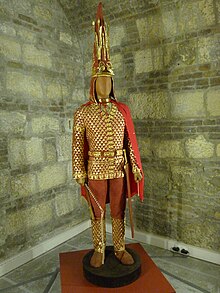Issyk Golden Cataphract Warrior


The Issyk Golden Cataphract Warrior, is a suit of armor consisting of thousands of gold pieces found by chance in 1969 during the construction of a garage and road improvement works at the Issyk burial mound in the south of the country of Almaty.[1] It was recovered from the Issyk kurgan, which was examined by a team of archaeologists from the Kazakhstan Institute of History, Ethnography and Archaeology headed by Kimal Akishev.
It is thought to have belonged to the Scythians[2] or Sakas.[3] The Golden Cataphract Warrior is thought to be a Saka prince or princess around the age of 18, since he dates to the 4th century BC and the region where the kurgan was found was ruled by the Sakas in the 4th century BC.[4] The armor was exhibited in Ankara for 2 weeks in 2019 and then moved back to Kazakhstan. Today, it is exhibited in the National Museum of the Republic of Kazakhstan.[5]
References[edit]
- ^ "Kazakh 'Golden Man' to be reburied". BBC News. 4 January 2019. Archived from the original on 5 September 2023. Retrieved 27 January 2024.
- ^ Kuzmina 2007, p. 103 "The dress of Iranian-speaking Saka and Scythians is easily reconstructed on the basis of... numerous archaeological discoveries from the Ukraine to the Altai, particularly at Issyk in Kazakhstan... at Pazyryk... and Ak-Alakha"
- ^ Hanks, Reuel R. (2005). Central Asia: a global studies handbook. Global studies Asia. Santa Barbara, Calif.: ABC-CLIO. p. 168. ISBN 978-1-85109-656-5.
- ^ "Scythian Golden Man". World History Encyclopedia. 13 March 2021. Archived from the original on 6 March 2023. Retrieved 27 January 2024.
- ^ "Altın Elbiseli Adam'ın Türkiye yolculuğu sona eriyor". NTV. 14 October 2019. Archived from the original on 27 March 2023. Retrieved 27 January 2024.
Works cited[edit]
- Kuzmina, Elena Kuzmina (2007). The Origin of the Indo-Iranians. BRILL. ISBN 978-90-04-16054-5.
